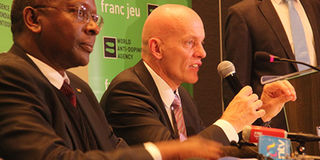Wada: No systematic doping in Kenya, but still cause for concern

Wada Director of Intelligence and Investigation Gunter Younger (right) addresses a press conference alongside Adak's Chief Executive Officer Japhter Rugut on the status of doping in Kenya on September 27, 2018 at the Trade Mark hotel, Nairobi. PHOTO | KANYIRI WAHITO |
What you need to know:
- AIU’s Brett Clothier, who declined to state the two other countries that top in doping cases, described the doping circumstances in Kenya as unique.
- Clotheir said the huge amount of prize money in races drive most Kenyan athletes to use short cuts.
- Adak CEO Japhter Rugut said they have cashed on the task force to learn, hence will set up functional units for investigation and intelligence.
The World Anti-Doping Agency’s (Wada) Intelligence and Investigations department has described doping cases in Kenya as serious and ranked the country among the top three nations with high cases of doping in the world.
However, Wada’s Director of Intelligence and Investigation Gunter Younger disclosed that doping practices of Kenyan athletes are unsophisticated, opportunistic, and uncoordinated.
"There is no evidence of an institutionalised system or criminal network involved," said Younger at a press conference in Nairobi on Thursday.
Younger explained that in its Kenya Project Taskforce report that also incorporated Anti-Doping Agency of Kenya (Adak) and the Athletics Integrity Unit (AIU) that most Kenyan elite athletes abuse the more complex and sophisticated Erythropoietin (Epo).
“The lower class of athletes use the nandrolone, which is cheap and easy to get, but mostly get caught on their first test,” said Younger, adding most of these banned performance enhancing drugs are easily obtained from pharmacies.
Younger noted that their project, that was commissioned in 2016, revealed that most athletes are unaware of what they are taking especially when it comes to nandrolone.
”Athletes in Kenya are insufficiently educated on doping and are wilfully blind as to the consequences of doping,” said the report, adding that local medical practitioners and quasi-medical personnel contribute to the accessibility of prohibited substances to athletes and their entourages.
Younger explained that some local medical practitioners and quasi-medical personnel are unaware, while others wilfully facilitate the access of athletes and their entourage to prohibited substances.
Asked whether Wada, Adak and AIU were winning the fight against doping, Younger said: “It’s not about winning the fight, what I want to say is that clean athletes when any doping cheat is caught. It’s about protecting the clean athletes and we won’t relent on that fight.”
However, Younger said that will it’s difficult to estimate how bad the doping situation in Kenya is, adding that they have tried to develop investigative capability since the formation of Adak in 2014.
“Lack of testing laboratory complicated the fight against doping since taking blood out of Kenya took long for the results to come out,” said Younger.
“We are now happy that the region will have its own (lab) in Nairobi. We are concerned about the high cases, but we are getting better.”
Younger is happy that there is no criminal network perpetrating doping in the country, but said they will continue to educate athletes and set up programmes for doping.
AIU’s Brett Clothier, who declined to state the two other countries that top in doping cases, described the doping circumstances in Kenya as unique.
Clotheir said the huge amount of prize money in races drive most Kenyan athletes to use short cuts.
Adak CEO Japhter Rugut said they have cashed on the task force to learn, hence will set up functional units for investigation and intelligence.
Before Adak was set up, Rugut said they were less than 100 cases tested but that increased to 1155 last year.
“We are targeting 1,500 and more this year with the new approach,” said Rugut.
The project’s objectives were two fold. First, to understand the doping practices of Kenyan athletes with the view to identifying those involved, at all levels; and secondly, to develop a multi-stakeholder network to better tackle Kenyan doping.
It targeted elite and sub-elite distance runners residing or training in Kenya and competing internationally and associated coaches, support staff, chaperones, doctors and ancillary medical staff.
It also involved Kenyan sporting officials where there was a credible link to corruption or other serious crime.




